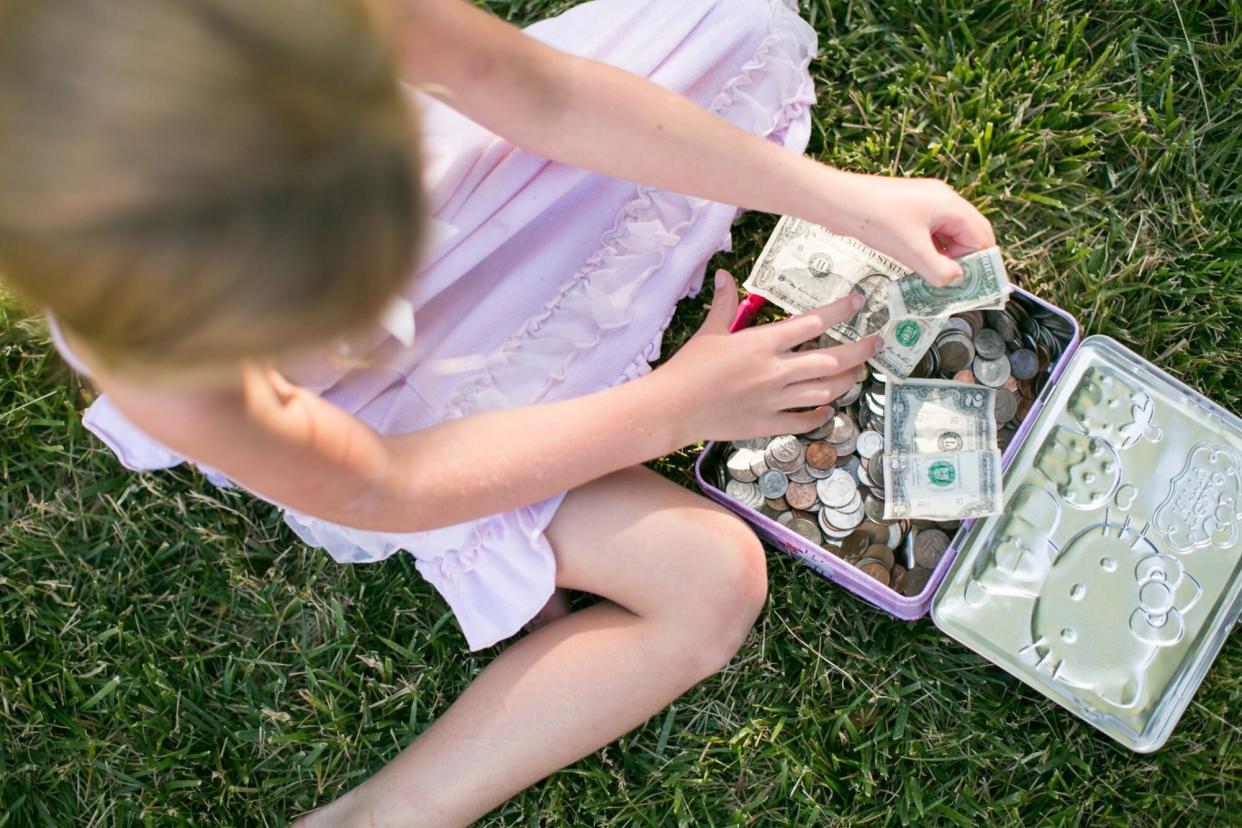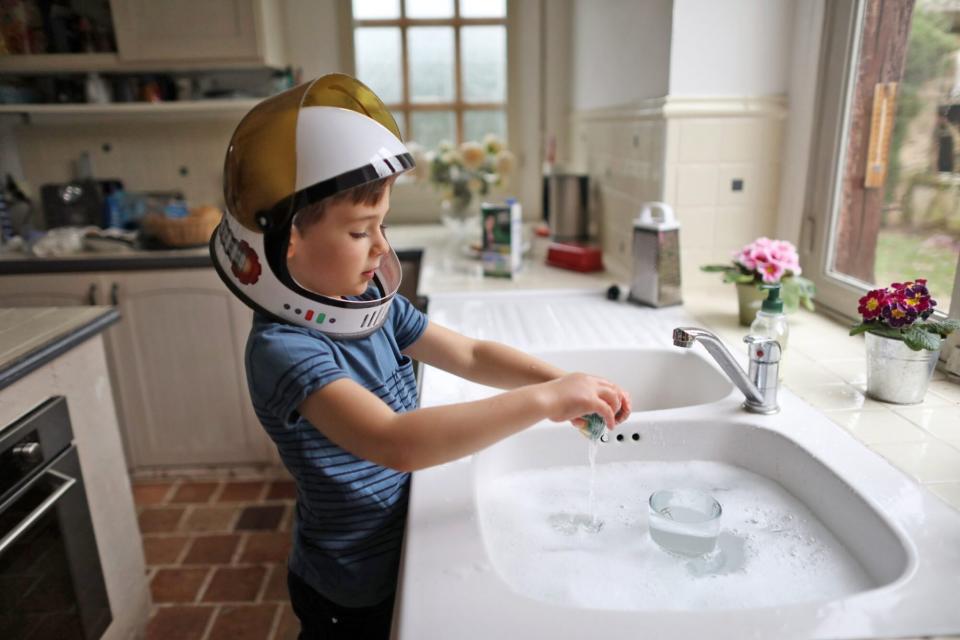5 Parents Share the Unwritten Rules of Allowances

Getty Images.
Many families teach children the value of money by implementing allowances. This pseudo-employment scheme can offer kids the chance to understand the concept of working for the things they want rather than waiting for mom or dad to fork over their own hard-earned cash when they feel like it. And allowance can also train kids to be responsible with money—and patient, both key outcomes of delaying monetary gratification. But while these money lessons are essential to financial literacy, parents might be shocked to hear just how varied allowance practices actually are these days.
There is truly no one-size-fits-all approach to allowances. Instead, allowance distribution depends on the money mindset parents hope to instill. Some parents use allowances to get a handle on their kids' behavior and to teach young adults how to be contributing members of a household. Others use allowance to create a predictable family budget that accounts for kids' wants and needs, as well as their investing interests in the future.
If "A" is for "Allowance," "B" is for "Budget"
Julina Ogilvie is a partner at a Connecticut-based financial advisory firm, Principle Wealth Partners, and a mom to two girls, ages 10 and 12. "We decided to pay them a weekly dollar amount based on their age, so currently they each get $10 and $12 a week," she tells Parents. "This is assuming they assist with weekly chores. which mainly consists of feeding our two dogs, emptying the dishwasher, and doing their laundry." Ogilvie says that while tracking and reminders can be difficult to manage, the consistency of allowance payments or withholdings—based on the kids' contributions—keeps her daughters in line.
To teach her kids to always save at a minimum 20% of income towards their savings, Ogilvie automatically saves 20% for them. "This is the foundation of 50/30/20 budgeting (50% needs, 30% wants, and 20% savings). We plan to invest their savings. When I asked my 10-year-old which company she believed would continue to grow, she said Amazon, because they showed up on our doorstep almost every day of the pandemic," Ogilvie laughs. "When she has saved enough, we will buy her a share."

Getty Images.
No Cash for Chores, Only Work for Hire
Paul Claybrook is the dad of six children ranging in age from ages 4 to 20. He and his wife have handled allowance the same way for the past 20 years: "There is none," he tells Parents. "However, we do provide opportunities for them to earn money." Claybrook is the owner of SuperDuperNutrition.com, so he treats allowances like an opportunity to teach entrepreneurship. Essential responsibilities like emptying garbage, mowing the lawn, and making beds are non-payable.
"Only after chores are completed, they may offer to do a job for money, or we may offer one to them. It is always a job above and beyond their regular chores; usually something my wife or I would normally do, like weeding flower beds, organizing the garage, or washing the car," explains Claybrook. This approach teaches them to negotiate the terms of work, deadlines, and pay scale. "When they think they are finished, we 'inspect' the work to ensure it meets the expectations we have for that particular child's age. Then, and only then, we pay them. If they do not complete the inspection, they are shown the flaws and invited to finish properly. This may happen multiple times until completion, but if they don't finish, they don't get paid," Claybrook says.
He believes this approach has been successful in teaching his three eldest to be self-sufficient. They started babysitting, became employed, and even launched entrepreneurial ventures. The Claybrooks caution that "If you give them a standard 'get something for nothing' allowance, or even one that pays them for doing things they should do anyway, kids can learn the opposite of the life lessons most parents intend to instill."

Getty Images.
Keep in Mind the Value of Time
Nicole Evert is a trained educator, mom of four, and founder of the Creating Butterflies blog, which offers stress-free and practical solutions to real-life parenting problems. The Everts, like the Claybrooks, don't want their kids to learn the mindset of receiving money with little effort expended.
"While an allowance can be an incredible way to help your child learn money management and saving in a safe environment before becoming an adult, we try to be mindful of how our child earns an allowance," Evert tells Parents. "If you pay your child $1 for a two-minute job, like wiping down the table after dinner, that is an hourly wage of $30! We try to be mindful of this so that our children learn the value of hard work."
Instead, her approach is to "discuss with the children the costs of extracurricular activities, materials needed, and other fun activities that they wish to do throughout the month. These are what they earn for helping with chores and other tasks around the house," Evert explains. Instead of using a weekly allowance to teach money management, savings, and banking, the Everts use money gifted from holidays and birthdays to impart those life lessons.

Getty Images
Digital Currency is Better than Cash
Jessica Clark is a mom to a 9-year-old boy. "My son rarely wants to buy anything tangible, but he is a major gamer," she tells Parents. "This is why we decided to purchase a premium Roblox subscription, where he receives 2000 Robux (in-game money) each month in lieu of a traditional allowance. The requirements for continuing to receive this allowance are simple. He just needs to have good behavior (not be rude or disrespectful) and complete his schoolwork."
This works particularly well because Clark homeschools, so she gets to monitor her son's performance both in the classroom and out. Their allowance routine started in the first grade, when he was six years old, and this has been an ideal incentive program to keep him engaged. Since the in-game cash technically doesn't correlate to an exact amount of time spent playing, he does have to learn to make his in-game money last the entire month.
Clark feels like this helps teach him some age-appropriate financial responsibility. Parents of tweens and teens might apply this same model to load up an e-wallet for recurring expenses such as Apple Music or Amazon purchases, or to make allowance cashless with apps such as Zelle, Venmo, or CashApp.
Set Auto-Deposits for Discretionary Spending
Lorie Anderson holds a Master's of Science in Education, Learning, Design, and Technology from Purdue University and is the brains behind the parenting blog MomInformed.com. She has a 6-year-old daughter, an 11-year-old son, and a 16-year-old stepson.
When asked to describe her allowance philosophy, Anderson shares that "we were one of the 'free and clear' allowance families. Beginning at about age 10, we set up savings accounts for each of our kids and direct-deposited a monthly amount ($25 to start) for allowance. Then, we sat down with each child and showed them how much they could save toward a bigger-ticket purchase, like a new game or even a new phone or console. We helped them set goals for savings and spending. We also explained that, while we would still pay for things like clothes and food, they would have to use their money wisely for discretionary spending."
She and her partner treat their kids' allowances like an automatic deduction—there are no work expectations set for the kids to earn it, and there are no reductions for bad behavior, etc. In this predictable way, the kids' bank accounts grew, and the Anderson kids soon learned how to manage their money. "When they begged for candy or toys, we referred them back to their allowance. It's funny to see how quickly a child's demands change when they're forced to spend their own money!"
Anderson learned that one child was adept at saving for big purchases, while the other was a spendthrift. Over the years, the kids negotiated a raise, and allowances increased. Today, the kids still use these accounts for personal savings. Looking back, Anderson says she is proud to see that her approach to allowances helped them prioritize purchases and learn the value of a dollar.

